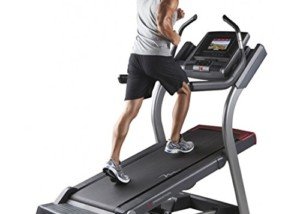
Are you morbidly obese and hold onto the treadmill for your walks? Stop doing this. It will sabotage your efforts to lose weight.
If you walked in the parking lot, in the gym, to the locker room, to the treadmill area without the assistance of a walker or cane…why would you then hold onto the treadmill for your walking exercise?
Ask if this makes sense.
You don’t want to fall off, right? Well, who put that idea into your head? Let me guess: You’ve seen nearly every treadmill user holding on.
This plants the idea that the machine is dangerous and you must hold on.
But the popularity of doing something that kills efficacy doesn’t make it a smart move.
What should a morbidly obese walker do if they feel they’ll fall off a treadmill?
• Use a slower speed.
• Lower the incline if you use one.
• Walk with confidence.
• Think of yourself as being lord over the machine, rather than the machine controlling you.
Why shouldn’t morbidly obese walkers hold onto a treadmill?
• It burns fewer calories.
• It creates a fake sense of fitness and mobility accomplishment.
• It does not carry over to real-world walking where there’s nothing to hold onto for support.
• It fails to promote erect posture.
• It does zero for strengthening the hip, knee and ankle joints.
• It deactivates the body’s balance mechanism; “de-trains” the body to efficiently negotiate unstable terrain outdoors.
• Can result in repetitive stress injuries at higher speeds.
• And less face it, wouldn’t you feel a lot more empowered if you stepped away from a 30 minute treadmill workout knowing that you didn’t hold on once?
Morbid obesity is no excuse for cheating with this equipment. Just because you get winded quickly after walking slowly for only several minutes doesn’t mean you must hold on.
Two ways for a morbidly obese person to walk on the treadmill:
• Steady state: Choose a speed and stick with it for the duration of your session.
• Interval training: Choose a baseline or “recovery” speed that’s a lot slower than what would challenge you.
• Every few minutes, deviate from that baseline with a faster speed that leaves you breathing hard within 30-60 seconds.
• Then return back to the baseline for a few minutes. Alternate this way for the duration of your session.
Interval training will produce results (improved heart health, stamina, fat-burning) faster than steady state. It’s also more tolerable because the total actual work time is much shorter.
Now you may find it highly tolerable to just do a leisurely steady state for 30 minutes. I see this all the time; the walker looks quite comfortable.
But if you decide to do steady state, it should not be comfortable. You should feel like you’re working at it.
Either way, do not hold onto the treadmill. It doesn’t matter if everyone and his or her brother is doing it. They are all wrong.
Even if you see someone with the body you want holding onto the treadmill, they are doing it WRONG; do not copy them!
That’s not how they got their great body!
When I was a personal trainer I’d see this all the time: A man or woman who was great with the physique-training strength routines, but then they’d get on a treadmill and hold on!
I once approached one of these individuals—a man who instructed karate. You’d think he of all people would know better, being skilled at balancing on one foot and kicking with the other.
He honestly had no idea that gripping the treadmill at 15 percent incline and 4 mph, leaning his body way back at the same angle, was cancelling out the incline and subtracting workload from his legs and core.
If you were walking outdoors for fitness/weight loss, you wouldn’t be holding onto anything.
You wouldn’t be grabbing at a fence along the sidewalk for support.
So why hold onto a treadmill? It just makes no sense. If letting go results in dizziness or a feeling of instability, then reduce the speed and use a zero incline. Give your body a chance to acclimate, even if you’re morbidly obese.








































